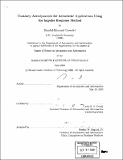Unsteady aerodynamics for aeroelastic applications using the impulse response method
Author(s)
Guendel, Randal Edmund, 1975-
DownloadFull printable version (9.516Mb)
Other Contributors
Massachusetts Institute of Technology. Dept. of Aeronautics and Astronautics.
Advisor
Carols E.S. Cesnik.
Terms of use
Metadata
Show full item recordAbstract
Aeroelasticity is a critical issue in the design of aircraft and other aerospace vehicles, particularly those with highly flexible components. A reliable but efficient analysis tool is required to aid decision-making in the preliminary design phase. This thesis focuses on the unsteady aerodynamics component of the total aeroelastic system. Classically unsteady aerodynamics has been grounded on the Theodorsen function, which identifies the response of a 2-D wing section to harmonic pitch and plunge oscillations. Recently, however, the Aerodynamic Impulse Response has emerged, identifying a more fundamental aerodynamic response of a discrete-time system as that to a unit impulse. With this response, the response to any motion in the time domain can be easily predicted. This thesis examines the Aerodynamic Impulse Response method using an aerodynamic panel code, PMARC, to obtain impulse responses. The basic formulation of the method is limited to rigid-body analyses and is thus of limited use to aeroelastic studies. To this end, the method is extended to flexible-body responses by considering impulse distribution functions that are related to structural mode shapes of the body. Both linear and nonlinear responses are considered: the former uses convolution to generate arbitrary responses, the later the Volterra series. Linear results for both rigid and flexible bodies are encouraging. Predictions for a range of input motions closely match the unsteady response from PMARC for the same motion. However, for harmonic motion accuracy erodes for f [Delta] t < 0.05, limiting the frequency range over which the model is accurate. Nonlinear responses are erratic and further study is required.
Description
Thesis (S.M.)--Massachusetts Institute of Technology, Dept. of Aeronautics and Astronautics, 2000. Also available online at the MIT Theses Online homepage <http://thesis.mit.edu>. Includes bibliographical references (p. 157-163).
Date issued
2000URI
http://theses.mit.edu/Dienst/UI/2.0/Describe/0018.mit.theses%2f2000-71http://hdl.handle.net/1721.1/9246
Department
Massachusetts Institute of Technology. Department of Aeronautics and AstronauticsPublisher
Massachusetts Institute of Technology
Keywords
Aeronautics and Astronautics.